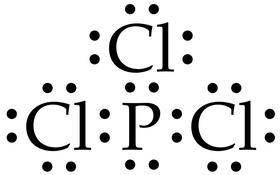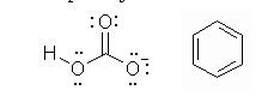View
- Term
- Definition
- Both Sides
Study
- All (89)
Shortcut Show
Next
Prev
Flip
CHEM 0310: STUDY GUIDE
valence electrons
|
the electrons in the outer shells of atoms that can participate in bonding. Each element generally forms certain fixed numbers of bonds: valence
|
Lewis Structures
|
electron dot formulas that show the valence electrons of atoms. lone-pairs are often omitted
|
octet rule
|
most 2nd and 3rd row elements prefer an eight (8) electron configuration i bonding (noble gas configuration)
|
Constitutional isomers
|
molecules with identical formula, but different connectivity between the atoms
|
electronegativity
|
the ability of an atom to attract electrons. The Pauling scale ranges from 4.0 (strongest, F) to 0.7 (weakest, Cs). The electron distribution within the bond reflects a continuum from covalent to ionic and is a function of the electronegativity of the bonded atoms
|
Electronegativity
|
Affinity for electrons
|
H electronegativity
|
2.2
|
C electronegativity
|
2.6 |
N electronegativity
|
3.0
|
O electronegativity
|
3.4
|
F electronegativity
|
4.0
|
resonance structures
|
chemical structures that differ only in the distribution of the π bond electrons
|
orbitals
|
plots of the square of the wave function (ψ2) that express a high probability of finding an electron within its perimeter.
|
nodes |
positions in space where ψ=0; the greater the number of nodes the higher the energy of the orbital
|
hybridization
|
combination of individual wave functions for s and p orbitals to obtain wave functions for new orbitals; sp3 ,sp2 ,sp (σ and π bonding)
|
dipole moment
|
a function of charge separation; equals distance times (partial) charge. Polar molecules have a dipole moment, but apolar molecule can also contain polar bonds whose dipole moments cancel each other.
|
molecular formula
|
C4H10O
|
condensed structural formulae
|
(CH3)2CHCH2OH or HOCH2CH(CH3)2
|


|
|
lewis dot structure
|


|
|
Bond-line formula.
|
alkanes |
parent compounds; methane, ethane. rotation around the C-C σ bond is easy. σ bonds have cylindrical symmetry
|
alkenes
|
parent compound; ethene. Rotation around the C=C π bond is impossible without breaking the bond (activation energy is approx 60 kcal/mol) Therefor cis- and trans- stereoisomers occur. π bonds have a nodal plane.
|
alkynes |
parent compound; ethyne. the C,C triple bond contains one σ bond and two π bonds. the two π bond orbitals are orthogonal
|
arenes |
arenes |
intermolecular forces
|
electrostatic interactions (ionic and dipole-dipole), Hydrogen bonding, Van der Waal,
|
solubilities |
polar solvents dissolve polar molecules and salts via dipole-dipole interactions and H-bonding. Apolar solvents dissolve apolar molecules via van der waals foreces. "like dissolves like"
|
What is organic chemistry?
|
Study of Carbon + its compounds
|
What are the key elements of organic chemistry?
|
1. Structure
2. Function
3. Relationship
|
Concept of Valency
|
-All atoms have fixed bonds.
-Group # = # valence electrons
4 bonds = tetravalent
3 bonds = trivalent
2 bonds= divalent
1 bond = monovalent
|
Trend of Electronegativity
|
Up + Right
|
Ionic Bonds
|
Widely different electronegativities
-Charged attraction (+) attracts (-)
|
Covalent Bonds
|
Sharing Electrons
-Same Atom/Same electronegativity.
|
Polar Covalent Bond
|
-Dipole movement
-Polar - Unbalanced charge
|
Bronsted-Lowry Acid
|
Proton Donor
|
Bronsted-Lowry Base
|
Proton Acceptor
|
What is the strongest base in water ?
|
OH-
|
What is the strongest acid in water?
|
H30+
|
What is Ka? How is it measured?
|
Ka = Keq * [H20]
|
How is pKa measured?
|
-log[Ka]
|
Ka and Equilibrium
|
Big Ka = favors products
Small Ka = favors reactants
|
Relationship between Ka and pKa
|
Strong Acid:
- Big Ka
- Small pKa
Weak Acid
-Small Ka
-Big pKa
|
Acidity in columns are determined by....
|
Bond strength!
|
Acidity in rows determined by...
|
Electronegativity
|
S orbitals stabilize...
|
(-) charge
|
H-H bond dissociation energy
|
104kcal/mol
|
H3C-H bond dissociation energy
|
105kcal/mol
|
H3C-I bond dissociation energy
|
57kcal/mol
|
H3C-F bond dissociation energy
|
110kcal/mol
|
H3C-Cl bond dissociation energy
|
85kcal/mol
|
H3C-Br bond dissociation energy
|
70kcal/mol
|
(CH3)3C-H bond dissociation energy
|
96.5kcal/mol
|
Cl-Cl bond dissociation energy
|
58kcal/mol
|
Cl-H bond dissociation energy
|
103kcal/mol
|
H-H eclipsing energy
|
1kcal/mol
|
H-CH3 eclipsing energy
|
1.2kcal/mol
|
CH3-CH3 eclipsing energy
|
2.9kcal/mol
|
CH3-CH3 gauche energy
|
0.9kcal/mol
|
Li electronegativity
|
1.0 |
Cl electronegativity
|
3.2
|
F radical formation energy
|
-103kcal/mol
|
I radical formation energy
|
13kcal/mol
|
Cl radical formation energy
|
-25kcal/mol
|
Br radical formation energy
|
-6kcal/mol
|
HI pKa value
|
-10
|
HBr pKa value
|
-9
|
HCl pKa value
|
-8
|
H2SO4 pKa value
|
-3
|
H3O+ pKa value
|
-1.7
|
HNO3 pKa value
|
-1.4
|
CH3SO3H pKa value
|
-1.2
|
HF pKa value
|
3.2
|
CH3COOH pKa value
|
4.7
|
HCN pKa value
|
9.2
|
NH4+ pKa value
|
9.3
|
CH3SH pKa value
|
10
|
CH3OH pKa value
|
15.5
|
H2O pKa value
|
15.7
|
NH3 pKa value
|
35
|
CH4 pKa value
|
~50
|
Csp3-H bond length
|
1.1A
|
C-C bond length
|
1.5A
|
C=C bond length
|
1.3A
|
C-I bond length
|
2.1A
|
C-O bond length
|
1.4A
|
O-H bond length
|
1.0A
|
C=O bond length
|
1.2A
|
Csp-Csp bond length
|
1.2A
|
C-Cl bond length
|
1.8A
|
C-Br bond length
|
1.9A
|